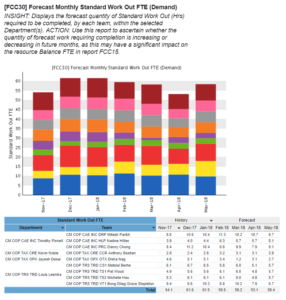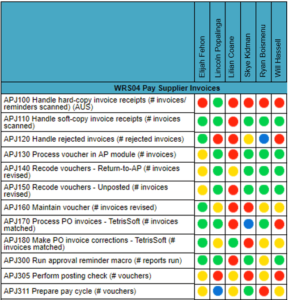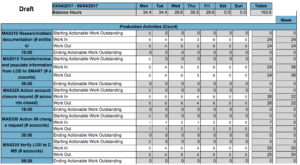Our Workforce Management team shares their Workforce Planning expertise in The Burnie Group’s Knowledge Hub
What is Workforce Scheduling?
Workforce Scheduling is a process by which the alignment of supply and demand is achieved by matching resources available to the volumes of work to be completed. Workforce scheduling is usually performed on a daily or weekly basis. The process must take into account established service level agreements (SLAs), individual employees’ skillset, labour regulations and corporate rules while minimizing cost to the business.
Workforce Planning and Workforce Forecasting, while related to Workforce Scheduling, differ mostly in that they represent different time horizons in the workforce management timeline. Workforce Scheduling may utilize the outputs of the Workforce Planning and Workforce Forecasting processes to forecast short-term demand.
|
SHORT-TERM VIEW [Daily/Weekly] |
MEDIUM-TERM VIEW [Monthly] |
LONG-TERM VIEW [Yearly/multi-year] |
|
WORKFORCE Weekly or intra-day capacity planning
|
WORKFORCE Monthly forecast of workload demand and workforce supply
|
WORKFORCE PLANNING Forecast of future business needs and workforce alignment to strategic plans
|
Find out how our Workforce Management specialists can help you get the most out of your workforce
CONNECT WITH USThe Workforce Scheduling Process
Whether performed manually or using Workforce scheduling software and other tools, the Workforce scheduling process follows three key steps.
1. Planning Supply
In organizations where employees follow a fixed schedule, items such as Paid time off need to be factored in when determining the amount of resource hours available to perform work. In general, supply will be somewhat consistent from week to week, save for employees joining or departing the team.
2. Planning Demand
Demand can be planned in a very granular fashion (i.e. planning all tasks to be completed by all employees at specific time intervals), or in a more generalized manner (i.e. determining how much volumes a team is to perform each day). In either case, it is important to determine the amount of time required to complete each task. This can be done using historical averages, or using different times depending on the level of skill of each individual.
Once a time is assigned to each activity, those can be assigned to teams/departments, or to specific individuals on a skills basis. Volumes may be established from historical information, or using volumes from monthly forecasts. Aside from volumes, plans should factor in time for trainings, meetings and other development activities staff engage in.
3. Balancing the plan
In this final step, the plan should be balanced; this means ensuring that planned supply and planned demand are aligned.
In order to align:
-Do staff have the required skillset to complete the planned activities?
-Are all activities falling within SLA?
-Will overtime be required? If so, could certain activities be moved to the backlog to minimize cost?
-What is the most efficient use of free capacity remaining?
Going through this process helps achieve workforce optimization. This not only means that supply matches demand, but also that this is done in the most cost efficient way (i.e. as little reliance on overtime as possible while providing acceptable levels of customer service). Once resources are aligned with work volumes, the plan is finalized. It may however require daily or intra-day adjustments in response to unexpected events (i.e. sick leave or volume spikes).
Workforce scheduling in operations and back office
While workforce scheduling is a common practice in industries that rely primarily on shift work, the concepts of workforce scheduling also apply to the back office or operations, which typically follow a traditional or fixed schedule.

Availability of staff
In organizations that follow fixed schedules, staff availability may still vary from one week to the next. Vacation, parental leave, short term disability, are all events that reduce the amount of resources available. Staff may also join or depart the team, leading to a change in capacity.

Capacity planning and balancing
Having an overall picture of the capacity situation allows front-line managers to be better prepared to respond unexpected events. Planning ahead also allows managers to make use of all resources available (i.e. borrowing from other teams, scheduling trainings on low volume days, efficient use of backlog, etc.) . This proactive rather than reactive approach often leads to lower costs to the business and improved customer service.

Expectations of work volumes
Many industries face seasonality of work volumes. It is important to recognize those patterns and incorporate them in planning, in order to avoid overstaffing or understaffing – both of which are very costly to the business. This variation in volumes can present itself in the form of intra-day spikes in volumes (eg.: late afternoon peak), peak days (eg: end of month), or yearly seasonality. Industries such as insurance may see increased volumes in P&C claims during summer floods; the loans industry may see an influx in student loan applications before the start of the school year; the asset management industry may experience peak volumes around the new year.

Workforce scheduling optimization
Matching available capacity to demand patterns while abiding by SLAs, minimizing latent capacity and curtailing reliance on overtime result in workforce optimization. In simpler terms, the business is completing the work in line with customer requirements at the lowest cost possible. Note that the “customer requirement” component here is key as it differentiates between a low-cost operating model and an optimized model.
Challenges of workforce scheduling







Would you like to know more about our Workforce Management solutions?
CONNECT WITH USWorkforce scheduling software
There are many tools available to assist in the workforce scheduling process, ranging from basic ones such as Excel, to more advanced and automated ones such as workforce management platforms that include scheduling modules. A good workforce scheduling software includes the following components:
Volumes forecasting: The software should be able to leverage historical data to forecast future demand on an individual activity and team basis, as well as identify any seasonality patterns.

Resource planning: A good software allows users to input usual work times for each individual, as well as any planned leave.

Skills inventory: In order to match team capacity to specific activities, users need to be able to determine if there are enough resources available with the skillset required for those activities.

Demand planning: The software should offer a fully or semi-automated tool for planning demand on an individual activity basis. Depending on the level of automation, the tool can incorporate previous numbers achieved as well as seasonality patterns for the specific period planned into the model. The model can then incorporate the allocated time of each activity to calculate the actual time required to complete planned volumes.

Balancing: Workforce scheduling tools can calculate the difference between planned supply and demand on a daily basis to identify whether the team will have a capacity shortage or surplus each day. The tool should make the balancing process easier by allowing for live edits and recalculation of the daily balance.

Real-time monitoring: Once the plan is created, an additional feature that is useful in managing capacity is real-time monitoring of volumes. This allows team leaders to proactively respond to unexpected shifts in demand and prioritize certain tasks.

Benefits of workforce scheduling
As discussed in previous sections, workforce scheduling carries direct financial benefits to the firm in that it helps optimize workforce related costs. Additionally, it presents several non-financial benefits such as improved customer service, increased employee engagement through overtime reduction and skills improvement, intra-departmental collaboration and communication, etc.

Capacity across teams
Workforce scheduling provides senior management with a visualization of the capacity situation across teams, allowing them to make more informed decisions. This can have a significant impact on hiring, scheduling policies, and workflows amongst other things. For instance, rather than hiring for all available roles, leadership may notice all work can be performed without the need to replace a team member that left. They may also realize one team is in need of additional resources.

Short term volume predictions
The process of workforce scheduling converts long term and medium term forecasts into short term volume predictions. This allows organizations to ensure their short-term priorities align with long term strategic goals. For example, if a company’s long term goal is to offer the best customer service in the industry, one of the ways they may wish to do so is through faster service. With a clear picture of the current situation, leadership is able to assess their ability to perform the work in a shorter time frame, and determine how many additional resources may be required.

Real-time management
Real-time management involves proactive action intra-day in response to unexpected events. Workforce scheduling helps team leaders gain valuable insight into what work needs to be delayed in order to prioritize an unexpected workload. Taking a proactive approach allows organizations to meet customer expectations while keeping costs within control. In a scenario where a large volume of work comes in around midday, taking a reactive rather than proactive stance would probably lead to the team having to do overtime to complete work within SLA. By being proactive, a team leader can look at planned activities, delay those that can be delayed, and borrow a team member from another team if necessary. In this example, work is performed within the expected timeframe without having to incur additional overtime costs.

Communication
An often benefit of workforce scheduling is that enables communication across the organization. Team leaders can communicate with toverlooked heir team about the capacity situation in upcoming week or days; communication flows across teams as team leaders borrow from and loan to each other to meet demand; senior leadership collaborates with team leaders to best address their capacity requirements. This increased communication helps ensure objectives are shared across the firm and capacity related issues are addressed in a timely manner.

Review
Having a plan for the week or day offers an opportunity to review that previous week, and compare actual volumes to plan. This review helps complete the cycle, ensuring management shares learnings from previous weeks, find areas of improvement, and determine if resources are used in an optimized manner. For example, where a team leader faced higher volumes than predicted and was able to complete them without any overtime, they can share the actions they took with other team leaders in their area.

Overstaffing/understaffing
One of the more evident benefits of workforce scheduling is that it helps reduce overstaffing and understaffing, as well as the negative effects these have on an organization. Although aimed at ensuring customer service levels can be maintained, overstaffing carries a direct cost, and also leads to staff disengagement, lower productivity, turnover and loss of skill. Understaffing impacts customer service, quality, and employee engagement, leading to turnover and burnout. Workforce scheduling takes a proactive approach to managing resources, identifying capacity surpluses or deficits ahead of time, and addressing them by aligning resources to demand.

Employee engagement
Employee engagement influences staff performance and customer service. Workforce scheduling mitigates several causes of low engagement such as excess overtime, high variations in volumes, lack of training, lack of communication, unclear expectations, etc. Setting clear objectives for individuals and teams to attain and celebrating when those targets are reached positively influences employee engagement, as staff find a purpose to their work and share team goals.

Skills alignment
When predicting volumes and assigning activities to staff, managers obtain a clear picture of skills gaps within teams. Planning activities also allows management to schedule training to make use of free capacity, aligning those trainings to close skills gaps and meet company objectives. Organizations can thereby ensure their workforce has the skills required to meet their strategic objectives.
Workforce management consulting
The Burnie Group has supported various organizations with Workforce Scheduling consulting and Operational Excellence. Our Achieve program targets organizations across various industries using a modern Workforce Management platform that includes data capture, data analytics, predictive analytics, advanced reporting, skills management and much more.
We have delivered workforce scheduling consulting across multiple industries including:
- Financial services (e.g. retails banking, business banking, institutional accounting)
- Life insurance
- Property and Casualty insurance
- Commercial real estate
- Retirement services
- Long-term care
- Consulting and advisory
- Many others
From a functional perspective we have delivered workforce scheduling solutions in the following areas of an organization:
- Operations and back-office (e.g. changes processing, documentation, credit checks, etc)
- Client onboarding
- Finance and accounting
- Human Resources
- Client services
- Legal services
- Management of existing customers / policy administration / plan administration
- Claims management
- Risk management
- And many more
Find out more on workforce management consulting in different industries.
Would you like to know more about our Workforce Management solutions?
CONNECT WITH US

